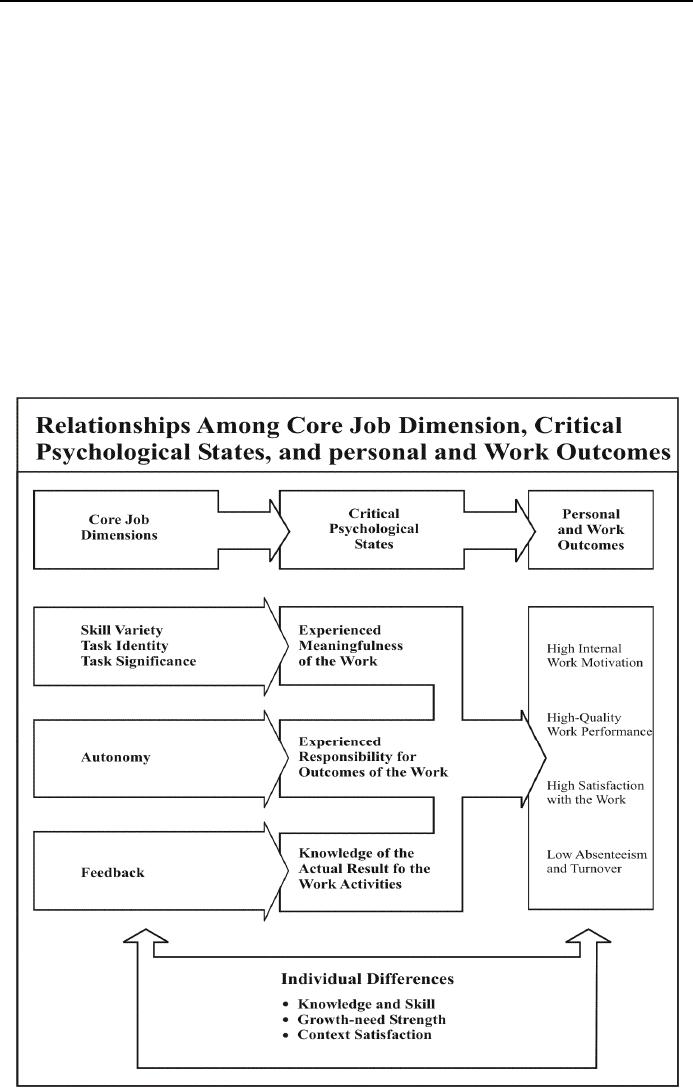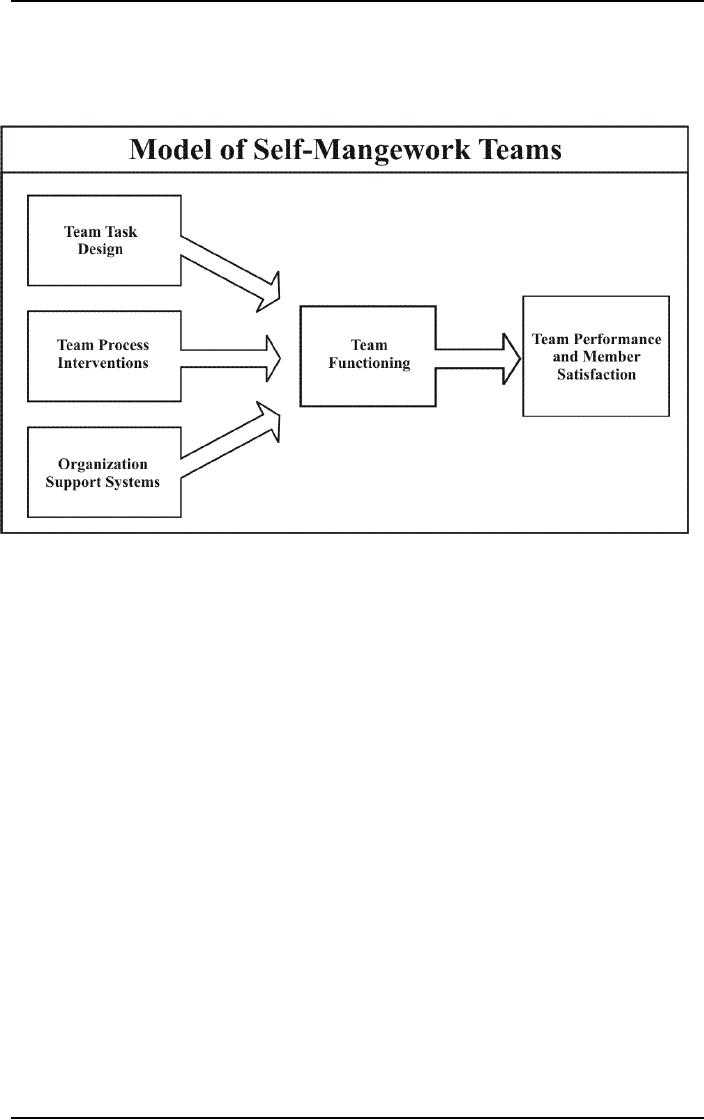 |

Organization
Development MGMT
628
VU
Lesson
38
Work
Design
Work
design has been researched
and applied extensively in organizations.
Recently, organizations
have
tended
to combine work design with
formal structure and
supporting changes in goal
setting, reward sys-
tems,
work environment, and other
performance management practices.
These organizational factors
can
help
structure and reinforce the kinds of work
behaviors associated with
specific work designs
We
will examine three
approaches to work design. First, the
engineering approach, which
focuses on
efficiency
and simplification, and
results in traditional job
and work group designs.
Second approach to
work
design rests on motivational
theories and attempts to enrich the
work experience. The third
and most
recent
approach to work design
derives from socio-technical
systems methods, and seeks
to optimize both
the
social and the technical
aspects of work
systems.
The
Engineering Approach:
The
oldest and most prevalent
approach to designing work is
based on engineering concepts
and methods.
It
proposes that the most
efficient work designs can
be determined by clearly specifying the
tasks to be
performed,
the work methods to be used,
and the work flow among
individuals. The engineering
approach
is
based on the pioneering work of Frederick
Taylor, the father of scientific
management. He developed
methods
for analyzing and designing
work and laid the foundation
for the professional field of
industrial
engineering.
The
engineering approach scientifically
analyzes workers' tasks to
discover those procedures
that produce
the
maximum output with the
minimum input of energies
and resources. This
generally results in
work
designs
with high levels of
specialization and specification. Such
designs have several
benefits: they allow
workers
to learn tasks rapidly; they
permit short work cycles so
performance can take place
with little or no
mental
effort; and they reduce
costs because lower-skilled people can be
hired and trained easily and
paid
relatively
low wages.
The
engineering approach produces
two kinds of work design:
traditional jobs and
traditional work
groups.
When
the work can be completed by
one person, such as with
bank tellers and telephone
operators,
traditional
jobs are created. These
jobs tend to be simplified,
with routine and repetitive
tasks having clear
specifications
concerning time and motion.
When the work requires
coordination among people,
such as
on
automobile assembly lines,
traditional work groups are
developed. They are composed
of members
performing
relatively routine yet related
tasks. The overall group
task is typically broken
into simpler,
discrete
parts (often called jobs).
The tasks and work
methods are specified for
each part, and the parts
are
assigned
to group members. Each
member performs a routine and
repetitive part of the group
task.
Members'
separate task contributions
are coordinated for overall
task achievement through
such external
controls
as schedules, rigid work flows,
and supervisors. In the 1950s
and 1960s, this method of
work
design
was popularized by the assembly lines of
American automobile manufacturers and
was an important
reason
for the growth of American industry
following World War
II.
The
engineering approach to job
design is less an OD intervention
than a benchmark in history.
Critics of
the
approach argue that the method
ignores workers' social and
psychological needs. They suggest
that the
rising
educational level of the workforce and
the substitution of automation for menial
labor point to the
need
for more enriched forms of
work in which people have
greater discretion and are
more challenged.
Moreover,
the current competitive climate requires a
more committed and involved
workforce able to
make
online decisions and to develop
performance innovations. Work
designed with the employee in
mind
is
more humanly fulfilling and
productive than that
designed in traditional ways.
However, it is important to
recognize
the strengths of the engineering
approach. It remains an important
work design
intervention
because
its immediate cost savings
and efficiency can be measured readily,
and because it is well
understood
and
easily implemented and
managed.
The
Motivational Approach:
The
motivational approach to work
design views the effectiveness of
organizational activities primarily as
a
function
of member needs and
satisfaction, and seeks to
improve employee performance
and satisfaction
by
enriching jobs. The motivational method
provides people with opportunities for
autonomy,
responsibility,
closure (that is, doing a
complete job), and
performance feedback. Enriched
jobs are popular
in
the United States at such
companies as AT&T Universal Card,
TRW, Dayton Hudson, and
GTE.
The
motivational approach usually is
associated with the research of Herzberg
and of Hackman and
Oldham.
Herzberg's two-factor theory of
motivation proposed that
certain attributes of work, such
as
opportunities
for advancement and
recognition, which he called motivators,
help increase job
satisfaction.
Other
attributes that Herzberg called hygiene
factors, such as company
policies, working conditions,
pay,
and
supervision, do not produce
satisfaction but rather prevent
dissatisfaction--important
contributors

Organization
Development MGMT
628
VU
because
only satisfied workers are
motivated to produce. Successful
job enrichment experiments at
AT&T,
Texas
Instruments, and Imperial Chemical
Industries helped to popularize job enrichment in the
1960s.
Although
Herzberg's motivational factors
sound appealing, increasing
doubt has been cast on
the
underlying
theory. Motivation and
hygiene factors are
difficult to put into
operation and measure, and
that
makes
implementation and evaluation of the
theory difficult. Furthermore, important
worker characteristics
that
can affect whether people will respond
favorably to job enrichment were
not included in his
theory.
Finally,
Herzberg's failure to involve
employees in the job enrichment process
itself does not suit most
OD
practitioners
today. Consequently, a second,
well-researched approach to job
enrichment has been favored.
It
focuses on the attributes of the work
itself and has resulted in a
more scientifically acceptable theory
of
job
enrichment than Herzberg's model. The
research of Hackman and Oldham
represents this more
recent
trend
in job enrichment.
The
Core Dimensions of
Jobs:
Considerable
research has been devoted to
defining and understanding core
job dimensions. Figure 50
summarizes
the Hackman and Oldham model of job
design. Five core dimensions
of work affect three
critical
psychological states, which in
turn produce personal and
job outcomes. These outcomes
include
high
internal work motivation,
high-quality work performance,
satisfaction with the work,
and low
absenteeism
and turnover. The five
core job dimensions--skill
variety, task identity, task
significance,
autonomy,
and feedback from the work
itself--are described below
and associated with the
critical
psychological
states that they
create.
Figure
50

Organization
Development MGMT
628
VU
Skill
Variety, Task Identity, and
Task Significance:
These
three core job
characteristics influence the extent to which
work is perceived as meaningful.
Skill
variety
refers to the number and types of
skills used to perform a particular
task. Employees at
Lechmere's,
a
retail chain in Florida, can
work as warehouse stock
clerks, cashiers, and
salespeople. The more tasks
an
individual
performs, the more meaningful the job
becomes. When skill variety is
increased by moving a
person
from one job to another, a
form of job enrichment called
job rotation is accomplished.
However,
simply
rotating a person from one
boring job to another is not
likely to produce the outcomes
associated
with
a fully enriched job.
Task
identity describes the extent to which an
individual performs a whole piece of
work. For example, an
employee
who completes an entire wheel
assembly for an airplane,
including the tire, chassis,
brakes, and
electrical
and hydraulic systems has
more task identity and
will perceive the work as
more meaningful than
someone
who only assembles the
braking subsystem. Job
enlargement, another form of job
enrichment
that
combines increases in skill variety
with task identity, blends
several narrow jobs into one
larger,
expanded
job. For example, separate
machine set-up, machining,
and inspection jobs might be
combined
into
one. This method can
increase meaningfulness, job
satisfaction, and motivation
when employees
comprehend
and like the greater task
complexity.
Task
significance represents the impact
that the work has on others.
In jobs with high task
significance,
such
as nursing, consulting, or manufacturing something
like sensitive parts for the
space shuttle, the
importance
of successful task completion
creates meaningfulness for the
worker.
Experienced
meaningfulness is expressed as an average
of these three dimensions.
Thus, although it is
advantageous
to have high amounts of
skill variety, task
identity, and task
significance, a strong
emphasis
on
any one of the three
dimensions can, at least
partially, make up for
deficiencies in the other
two.
Autonomy:
This
refers to the amount of independence, freedom,
and discretion that the employee
has to schedule and
perform
tasks. Salespeople, for
example, often have
considerable autonomy in how they
contact, develop,
and
close new accounts, whereas
assembly-line workers often
have to adhere to work
specifications clearly
detailed
in a policy-and-procedure manual. Employees
are more likely to
experience responsibility for
their
work
outcomes when high amounts of autonomy
exist.
Feedback
from the Work
Itself:
This
core dimension represents the information
that workers receive about the
effectiveness of their
work.
It
can derive from the work itself, as when
determining whether an assembled part
functions properly or it
can
come from such external
sources as reports on defects, budget
variances, customer satisfaction,
and the
like.
Because feedback from the
work itself is direct and
generates intrinsic satisfaction, it is
considered
preferable
to feedback from external
sources.
Skill
variety, task identity, and
task significance jointly
determine jobs
meaningfulness.
These
three dimensions are treated
as one dimension in the Motivation
Potential Score formula, or
MPS:
Motivation
Potential Score (MPS) =
Job
Meaningfulness x
Autonomy
x
Job
Feedback
The
first variable in the formula, job
meaningfulness, is a function of skill
variety, task identity, and
task
significance.
Thus the formula can further
be refined:
Motivation
Potential Score (MPS) = [Skill
Variety + Task identity +
Task significance] x
Autonomy
x Job Feedback
3
A
score of near zero on either the autonomy
or job feedback dimension will produce an
MPS of near zero.
Whereas
a number near zero on skill
variety, task identity or
task significance will
reduce the total MPS,
but
will
not completely undermine the motivational
potential of a job.
We
can predict employee's psychological
state from this
formula.
High
scores in Skill variety,
task variety, and task
significance result in the employee's
experiencing
meaningfulness
in job, such as believing the
work to be important, valuable,
and worthwhile.
A
high score in the autonomy dimension
leads to the employee's feeling
personally responsible
and
accountable
for the results of the
work.
A
high score in the job
feedback dimension is an indication that
the employee has an understanding of
how
he
or she is performing the
job.
Self
managed teams (to be
discussed later) have high
scores on all the five core
job dimensions.
Individual
Differences:
Not
all people react in similar
ways to job enrichment interventions.
Individual differences--among
them,
a
worker's knowledge and skill
levels, growth-need strength, and
satisfaction with contextual
factors--
moderate
the relationships among core dimensions,
psychological states, and
outcomes. "Worker
knowledge
and skill" refers to the education
and experience levels
characterizing the workforce. If
employees
lack the appropriate skills, for
example, increasing skill variety
may not improve a
job's
meaningfulness.
Similarly, if workers lack the intrinsic
motivation to grow and develop personally,
attempts

Organization
Development MGMT
628
VU
to
provide them with increased autonomy
may be resisted. Finally, contextual
factors include reward
systems,
supervisory style, and co-worker
satisfaction. When the employee is
unhappy with the work
context,
attempts to enrich the work itself
may be unsuccessful.
Application
Stages:
The
basic steps for job
enrichment as described by Hackman and
Oldham include making a thorough
diagnosis
of the situation, forming natural work units,
combining tasks, establishing client
relationships,
vertical
loading, and opening feedback
channels.
Making
a Thorough Diagnosis:
The
most popular method of diagnosing a
job is through the use of the
Job Diagnostic Survey (JDS) or
one
of
its variations. An important output of
the JDS is the motivating potential
score, which is a function of
the
three psychological states--experienced
meaningfulness, autonomy, and
feedback. The survey can
be
used
to profile one or more jobs,
to determine whether motivation and
satisfaction are really problems
or
whether
the job is low in motivating
potential, and to isolate
specific job aspects that
are causing
difficulties.
Forming
Natural Work
Units:
As
much as possible, natural work units
should be formed. Although there
may be a number of
technological
constraints, interrelated task activities should be
grouped together. The basic question
in
forming
natural work units is "How can
one increase 'ownership' of the task?"
Forming such natural units
increases
two of the core dimensions--task identity
and task significance--that
contribute to the
meaningfulness
of work.
Combining
Tasks:
Frequently,
divided jobs can be put
back together to form a new
and larger one. In the
Medfield,
Massachusetts,
plant of Corning Glass
Works, the task of assembling
laboratory hotplates was
redesigned
by
combining a number of previously separate
tasks. After the change,
each hotplate was
completely
assembled,
inspected, and shipped by
one operator, resulting in increased
productivity of 84 percent.
Controllable
rejects dropped from 23
percent to less than 1
percent, and absenteeism
dropped from 8
percent
to less than 1 percent. A later
analysis indicated that the change in
productivity was the result of
the
intervention.
Combining tasks increases
task identity and allows a
worker to use a greater variety of
skills.
The
hotplate assembler can
identify with a product
finished for shipment, and
self-inspection of his or her
work
adds greater task
significance, autonomy, and
feedback from the job
itself.
Establishing
Client Relationships:
When
jobs are split up, the typical
worker has little or no
contact with, or knowledge of, the
ultimate user
of
the product or service. Improvements
often can be realized
simultaneously on three of the
core
dimensions
by encouraging and helping
workers to establish direct relationships
with the clients of
their
work.
For example, when a typist
in a typing pool is assigned to a
particular department, feedback
increases
because
of the additional opportunities for
praise or criticism of his or
her work. Because of the
need to
develop
interpersonal skills in maintaining the client relationship,
skill variety may increase. If the
worker is
given
personal responsibility for deciding how
to manage relationships with clients,
autonomy is increased.
Three
steps are needed to create
client relationships: (1) the
client must be identified;
(2) the contact
between
the client and the worker needs to be
established as directly as possible;
and (3) criteria and
procedures
are needed by which the
client can judge the quality
of the product or service received
and relay
those
judgments back to the worker.
For example, even
customer-service representatives and
data-entry
operations
can be set up so that people
serve particular clients. In the hotplate
department, personal
nametags
can be attached to each instrument.
The Indiana Bell Telephone
Company found
substantial
improvements
in satisfaction and performance when
telephone directory compilers were given
accountabil-
ity
for a specific geographic
area.
Vertical
Loading:
The
intent of vertical loading is to decrease
the gap between doing the
job and controlling the job.
A
vertically
loaded job has responsibilities
and controls that formerly
were reserved for
management. Vertical
loading
may well be the most crucial
of the job-design principles. Autonomy is invariably
increased. This
approach
should lead to greater feelings of
personal accountability and responsibility
for the work
outcomes.
For example, at an IBM plant
that manufactures circuit boards
for personal computers,
assembly
workers
were trained to measure the accuracy
and speed of production
processes and to test the
quality of

Organization
Development MGMT
628
VU
finished
products. Their work is more
''whole/' they are more
autonomous, and the engineers
who used to
measure
and test are free to
design better products and
more efficient ways to
manufacture them.
Loss
of vertical loading usually occurs
when someone has made a
mistake. Once a supervisor
steps in, the
responsibility
may be removed indefinitely.
For example, many skilled
machinists have to complete
forms
to
have maintenance people work on a
machine. The supervisor automatically
signs the slip rather than
al-
lowing
the machinist either to repair the machine or
ask directly for maintenance
support.
Opening
Feedback Channels:
In
almost all jobs, approaches
exist to open feedback channels
and help people learn whether
their
performance
is remaining at a constant level, improving, or
deteriorating. The most advantageous
and least
threatening
feedback occurs when a
worker learns about performance as the
job is performed. In the
hotplate
department at Corning Glass Works,
assembling the entire instrument and
inspecting it
dramatically
increased the quantity and
quality of performance information
available to the operators. Data
given
to a manager or supervisor often
can be given directly to the employee.
Computers and other
automated
operations can be used to provide people
with data not currently
accessible to them.
Many
organizations
simply have not realized the
motivating impact of direct, immediate
feedback.
Barriers
to Job Enrichment:
As
the application of job enrichment has
spread, a number of obstacles to significant
job restructuring have
been
identified. Most of these
barriers exist in the organizational
context within which the job
design is
executed.
Other organizational systems and
practices, whether technical, managerial,
or personnel, can
affect
both the implementation of job enrichment
and the lifespan of whatever changes
are made.
At
least four organizational systems
can constrain the implementation of
job enrichment:
1.
The technical system. The
technology of an organization can limit
job enrichment by constraining the
number
of ways jobs can be changed.
For example, long-linked technology
like that found on an
assembly
line
can be highly programmed and
standardized, thus limiting the amount of
employee discretion that is
possible.
Technology also may set an
"enrichment ceiling." Some
types of work, such as
continuous-
process
production systems, may be naturally
enriched so there is, little
more that can be gained
from a job
enrichment
intervention.
2.
The personnel system. Personnel
systems can constrain job
enrichment by creating formalized
job
descriptions
that are rigidly defined
and limit flexibility in
changing people's job
duties. For example,
many
union
agreements include such narrowly
defined job descriptions
that major renegotiation between
man-
agement
and the union must occur
before jobs can be significantly
enriched.
3.
The control system. Control
systems, such as budgets,
production reports, and
accounting practices,
can
limit the complexity and
challenge of jobs within the
system. For example, a
company working on a
government
contract may have such strict
quality control procedures
that employee discretion is
effectively
curtailed.
4.
The supervisory system. Supervisors
determine to a large extent the amount of autonomy
and
feedback
that subordinates can
experience. To the extent that
supervisors use autocratic
methods and
control
work-related feedback, jobs will be
difficult, if not impossible, to
enrich.
Once
these implementation constraints
have been overcome, other
factors determine whether the
effects
of
job enrichment are strong and
lasting. Consistent with the contingency
approach to OD, the
staying
power
of job enrichment depends largely on
how well it fits and is
supported by other organizational
practices,
such as those associated
with training, compensation,
and supervision. These
practices need to be
congruent
with and to reinforce jobs having
high amounts of discretion, skill
variety, and meaningful
feedback.
The
Sociotechnical Systems
Approach:
The
sociotechnical systems (STS)
approach currently is the most extensive
body of scientific and applied
work
underlying employee involvement
and innovative work designs.
Its techniques and design
principles
derive
from extensive action research in
both public and private
organizations across diverse
national
cultures.
This section reviews the conceptual
foundations of the STS approach
and then describes its
most
popular
application--self-managed work
teams.
Conceptual
Background:
Sociotechnical
systems theory was developed
originally at the Tavistock Institute of
Human Relations in
London
and has spread to most
industrialized nations in a little more
than fifty years. In Europe
and
particularly
Scandinavia, STS interventions
are almost synonymous with
work design and
employee
involvement.
In Canada and the United
States, STS concepts and
methods underlie many of the
innovative
work
designs and team-based
structures that are so prevalent in
contemporary organizations. Intel

Organization
Development MGMT
628
VU
Corporation,
United Technologies, General Mills, and
Procter & Gamble are among the
many
organizations
applying the STS approach to
transforming how work is
designed and performed.
STS
theory is based on two fundamental
premises: that an organization or work
unit is a combined, social-
plus-technical
system (sociotechnical), and
that this system is open in relation to
its environment.
Sociotechnical
System:
The
first assumption suggests
that whenever human beings
are organized to perform
tasks, a joint system
is
operating--a
sociotechnical system. This system
consists of two independent but
related parts: a social
part
including
the people performing the tasks and the
relationships among them, and a
technical part
comprising
the tools, techniques, and methods
for task performance. These
two parts are independent
of
each
other because each follows a
different set of behavioral laws.
The social part operates
according to
biological
and psychosocial laws,
whereas the technical part
functions according to mechanical
and physical
laws.
Nevertheless, the two parts
are related because they
must act together to accomplish
tasks. Hence, the
term
sociotechnical signifies the joint
relationship that must occur
between the social and
technical parts,
and
the word system communicates
that this connection results in a unified
whole.
Because
a sociotechnical system is composed of
social and technical parts,
it follows that it will
produce
two
kinds of outcomes: products, such as
goods and services; and
social and psychological
consequences,
such
as job satisfaction and commitment.
The key issue is how to
design the relationship between the
two
parts
so that both outcomes are
positive (referred to as joint
optimization). Sociotechnical
practitioners
design
work and organizations so
that the social and
technical parts work well
together, producing high
levels
of product and human
satisfaction. This effort contrasts
with the engineering approach to
designing
work,
which focuses on the technical component,
worries about fitting people in later,
and often leads to
mediocre
performance at high social
costs. The STS approach
also contrasts with the
motivational
approach
that views work design in
terms of human fulfillment
and can lead to satisfied
employees but
inefficient
work processes.
Environmental
Relationship:
The
second major premise underlying
STS theory is that such
systems are open to their environments.
As
discussed
earlier, open systems must interact with
their environments to survive and develop.
The
environment
provides the STS with necessary inputs of
energy, raw materials, and
information, and the
STS
provides the environment with products
and services. The key
issue here is how to design
the interface
between
the STS and its environment
so that the system has
sufficient freedom to function
while
exchanging
effectively with the environment. In what
is typically called boundary management,
STS
practitioners
structure environmental relationships
both to protect the system
from external disruptions
and
to facilitate the exchange of necessary
resources and information.
This enables the STS to
adapt to
changing
conditions and to influence the
environment in favorable directions.
In
summary, STS theory suggests
that effective work systems
jointly optimize the relationship
between
their
social and technical parts.
Moreover, such systems
effectively manage the boundary
separating and
relating
them to the environment. This allows them to
exchange with the environment
while protecting
themselves
from external disruptions.
Self-Managed
Work Teams:
The
most prevalent application of the STS
approach is self-managed work
teams. Alternatively referred to
as
self-directed, self-regulating, or high-performance
work teams, these work
designs consist of
members
performing
interrelated tasks. Self-managed teams
typically are responsible
for a complete product
or
service,
or a major part of a larger production
process. They control members'
task behaviors and
make
decisions
about task assignments and
work methods. In many cases,
the team sets its own
production goals
within
broader organizational limits and may be
responsible for support services,
such as maintenance,
purchasing,
and quality control. Team
members generally are
expected to learn many if
not all of the jobs
within
the team's control and
frequently are paid on the basis of
knowledge and skills rather than
seniority.
When
pay is based on performance,
team rather than individual
performance is the standard.
Figure
51 is a model explaining how self-managed
work teams perform. It
summarizes current STS
research
and shows how teams
can be designed for high
performance. Although the model is based
mainly
on
experience with teams that
perform the daily work of the organization
(work teams), it also
has
relevance
to other team designs, such
as problem-solving teams, management
teams, cross-functional
integrating
teams, and employee
involvement teams. The model
shows that team performance
and member
satisfaction
follow directly from how
well the team functions: how
well members communicate
and
coordinate
with each other, resolve
conflicts and problems, and
make and implement
task-relevant
decisions.
Team functioning, in turn, is influenced
by three major inputs: team task
design, team process
interventions,
and organization support systems.
Because these inputs affect
how well teams function
and

Organization
Development MGMT
628
VU
subsequently
perform, they are key
intervention targets for
designing and implementing self-managed
work
teams.
Figure:
51
Team
Task Design:
Self-managed
work teams are responsible
for performing particular tasks;
consequently, how the team
is
designed
for task performance can
have a powerful influence on how
well it functions. Task
design
generally
follows from the team's
mission and goals that
define the major purpose of the team and
provide
direction
for task achievement. When a
team's mission and goals
are closely aligned with
corporate strategy
and
business objectives, members
can see how team
performance contributes to organization success.
This
can
increase member commitment to team
goals.
Team
task design links members'
behaviors to task requirements
and to each other. It
structures member
interactions
and performances. Three task
design elements are
necessary for creating
self-managed work
teams:
task differentiation, boundary control,
and task control. Task
differentiation involves the extent to
which
the team's task is autonomous
and forms a relatively self-completing whole. High
levels of task
differentiation
provide an identifiable team boundary
and a clearly defined area
of team responsibility. At
Johnsonville
Sausage, for example,
self-managed teams comprise
seven to fourteen members.
Each team is
large
enough to accomplish a set of interrelated
tasks but small enough to
allow face-to-face meetings
for
coordination
and decision making. In many
hospitals, self-managed nursing teams
are formed around
interrelated
tasks that together produce a relatively
whole piece of work. Thus,
nursing teams may be
responsible
for particular groups of patients,
such as those in intensive care or
undergoing cancer treat-
ments,
or they may be accountable for
specific work processes,
such as those in the laboratory,
pharmacy,
or
admissions office.
Boundary
control involves the extent to which
team members can influence
transactions with their
task
environment--the
types and rates of inputs
and outputs. Adequate boundary control
includes a well-
defined
work area; group responsibility
for boundary-control decisions,
such as quality assurance
(which
reduces
dependence on external boundary regulators,
such as inspectors); and
members sufficiently trained
to
perform tasks without relying heavily on
external resources. Boundary control
often requires
deliberate
cross-training
of team members to take on a variety of
tasks. This makes members
highly flexible and
adaptable
to changing conditions. It also reduces
the need for costly overhead
because members can
perform
many of the tasks typically assigned to
staff experts, such as those in
quality control, planning,
and
maintenance.
Task
control involves the degree to which
team members can regulate
their own behavior to
provide
services
or to produce finished products. It
includes the freedom to choose work
methods, to schedule

Organization
Development MGMT
628
VU
activities,
and to influence production goals to
match both environmental and
task demands. Task
control
relies
heavily on team members having the power
and authority to manage equipment,
materials, and other
resources
needed for task performance.
This "work authority" is essential if
members are to take
responsibility
for getting the work accomplished.
Task control also requires
that team members
have
accurate
and timely information about
team performance to allow them to
detect performance
problems
and
make necessary
adjustments.
Task
control enables self-managed
work teams to observe and
control technical variances as
quickly and as
close
to their source as possible.
Technical variances arise
from the production process
and represent
significant
deviations from specific goals or
standards. In manufacturing; for example,
abnormalities in raw
material,
machine operation, and work
flow are sources of variance
that can adversely affect the
quality and
quantity
of the finished product. In service
work, out-of-the-ordinary requests,
special favors or treatment,
or
unique demands create variances
that can place stress on the
process. Technical variances
traditionally
are
controlled by support staff and
managers, but this can take
time and add greatly to
costs. Self-managed
work
teams, on the other hand,
have the freedom, skills, and
information needed to control
technical
variances
online when they occur. This affords
timely responses to production
problems and reduces
the
amount
of staff overhead needed.
Team
Process interventions:
A
second key input to team
functioning involves team
process interventions. As discussed
earlier teams
may
develop ineffective social processes
that impede functioning and
performance, such as
poor
communication
among members, dysfunctional roles
and norms, and faulty
problem solving and
decision
making.
Team process interventions,
such as process consultation and
team building, can resolve
such
problems
by helping members address
process problems and moving
the team to a more mature
stage of
development.
Because self-managed work
teams need to be self-reliant, members
generally acquire
their
own
team process skills. They
may attend appropriate training programs
and workshops or they may
learn
on
the job by working with OD practitioners
to conduct process interventions on their
own teams.
Although
members' process skills
generally are sufficient to
resolve most of the team's
process problems,
OD
experts occasionally may
need to supplement the team's
skills and help members
address problems
that
they are unable to
resolve.
Organization
Support Systems:
The
final input to team
functioning is the extent to which the
larger organization is designed to
support
self-managed
work teams. The success of
such teams clearly depends
on support systems that are
quite
different
from traditional methods of
managing. For example, a
bureaucratic, mechanistic organization
is
not
highly conducive to self-managed teams.
An organic structure, with
flexibility among units,
relatively
few
formal rules and procedures,
and decentralized authority, is
much more likely to support
and enhance
the
development of self-managed work teams.
This explains why such teams
are so prevalent in high-
involvement
organizations. Their different
features, such as flat, lean
structures, open information
systems,
and
team-based selection and
reward practices, all reinforce teamwork
and responsible
self-management.
A
particularly important support system
for self-managed work teams
is the external leadership. Self-
managed
teams exist along a spectrum
from having only mild influence
over their work to
near-autonomy.
In
many circumstances, such
teams take on a variety of functions
traditionally handled by
management.
These
can include assigning members to
individual tasks, determining the methods
of work, scheduling,
setting
production goals, and
selecting and rewarding members.
These activities do not make
external
supervision
obsolete, however. That leadership
role usually is changed to
two major functions:
working
with
and developing team members,
and assisting the team in
managing its
boundaries.
Working
with and developing team
members is a difficult process
and requires a different
style of managing
than
do traditional systems. The
team leader (often called a
team facilitator) helps team
members organize
themselves
in a way that allows them to
become more independent and
responsible. She or he must
be
familiar
with team-building approaches and
must assist members in learning the
skills to perform their
jobs.
Recent
research suggests that the
leader needs to provide
expertise in self-management. This
may include
encouraging
team members to be self-reinforcing about
high performance, to be self-critical of
low
performance,
to set explicit performance
goals, to evaluate goal
achievement, and to rehearse
different
performance
strategies before trying
them.
If
team members are to maintain
sufficient autonomy to control variance
from goal attainment, the
leader
may
need to help them manage
team boundaries. Where teams
have limited control over
their task
environment,
the leader may act as a
buffer to reduce environmental
uncertainty. This can include
mediating
and negotiating with other organizational
units, such as higher management, staff
experts, and
related
work teams. Research
suggests that better managers
spend more time in lateral
interfaces.

Organization
Development MGMT
628
VU
These
new leadership roles require
new and different skills,
including knowledge of
sociotechnical
principles
and group dynamics, understanding of
both the task environment
and the team's technology,
and
ability
to intervene in the team to help members
increase their knowledge and
skills. Leaders of
self-
managed
teams also should have the
ability to counsel members
and to facilitate communication
among
them.
Many
managers have experienced
problems trying to fulfill the complex
demands of leading
self-managed
work
teams. The most typical
complaints mention ambiguity about
responsibilities and authority, lack
of
personal
and technical skills and
organizational support, insufficient attention
from higher management,
and
feelings of frustration in the
supervisory job.
Characteristics
of Self-managed Work
Teams:
Self-managed
work teams may be used
organization-wide, at a work site
composed of a number of work
teams,
or within just a few work
teams. But to whatever
degree they are used, there
are several
characteristics
that are common to all
self-managed work team
sites.
The
structure of the organization or work
site is based on team
concepts. There
are few managerial
levels
in the plant or work site
structure and few job
descriptions.
There
is an egalitarian culture and a noticeable
lack of status symbols. There
are no management
dinning
rooms, no assigned parking
places, and no special
furniture or d�cor for
manager's offices. There is
no
special dress code; if
uniforms are required, everyone,
including the plant superintendent wears
the
uniform.
A
work team has a physical
site. There
are functional boundaries
that members can
identify.
The
number of people in a team is kept as
small as possible. Typical
size range from five to
fifteen
members.
Work
teams order material and
equipment. They
set goals, profit targets,
and also rewards for the
team
members.
They have a voice in who is hired
and fired.
Team
members have a sense of vision
for their team and their
organization.
A
vision provides direction and
energizes team behavior to
accomplish goals.
There
is strong partnership between
team members and management.
If
there is a labor union, the
union is also a member of the
partnership.
Team
members are different enough.
Members
learn because of variety of viewpoints,
backgrounds,
cultural
experiences and
training.
Information
of all types is openly shared.
The
information system needs to be
well developed and
available
to all members. Members are
knowledgeable in accounting and
statistical concepts for
decision
making.
Team
members should be skilled and knowledgeable in
their areas. Team
members should have
good
interpersonal skills and a desire
and ability to work with
others.
Training,
and specially cross-training, is a major requirement
of self-managed teams. The
success
of
a team depends on its
members being skilled and knowledgeable
in a variety of areas, including
technical
skills,
finance and accounting,
competition in the marketplace, and
group process.
Team
managers are knowledgeable of
customers, competitors, and suppliers.
The
primary emphasis
is
to focus on customers. From the
team's standpoint, a customer is someone
within the organization or
external
to the organization that uses the team's
product/service.
Table of Contents:
- The Challenge for Organizations:The Growth and Relevance of OD
- OD: A Unique Change Strategy:OD consultants utilize a behavioral science base
- What an “ideal” effective, healthy organization would look like?:
- The Evolution of OD:Laboratory Training, Likert Scale, Scoring and analysis,
- The Evolution of OD:Participative Management, Quality of Work Life, Strategic Change
- The Organization Culture:Adjustment to Cultural Norms, Psychological Contracts
- The Nature of Planned Change:Lewin’s Change Model, Case Example: British Airways
- Action Research Model:Termination of the OD Effort, Phases not Steps
- General Model of Planned Change:Entering and Contracting, Magnitude of Change
- The Organization Development Practitioner:External and Internal Practitioners
- Creating a Climate for Change:The Stabilizer Style, The Analyzer Style
- OD Practitioner Skills and Activities:Consultant’s Abilities, Marginality
- Professional Values:Professional Ethics, Ethical Dilemmas, Technical Ineptness
- Entering and Contracting:Clarifying the Organizational Issue, Selecting an OD Practitioner
- Diagnosing Organizations:The Process, The Performance Gap, The Interview Data
- Organization as Open Systems:Equifinality, Diagnosing Organizational Systems
- Diagnosing Organizations:Outputs, Alignment, Analysis
- Diagnosing Groups and Jobs:Design Components, Outputs
- Diagnosing Groups and Jobs:Design Components, Fits
- Collecting and Analyzing Diagnostic information:Methods for Collecting Data, Observations
- Collecting and Analyzing Diagnostic information:Sampling, The Analysis of Data
- Designing Interventions:Readiness for Change, Techno-structural Interventions
- Leading and Managing Change:Motivating Change, The Life Cycle of Resistance to Change
- Leading and managing change:Describing the Core Ideology, Commitment Planning
- Evaluating and Institutionalizing Organization Development Interventions:Measurement
- Evaluating and Institutionalizing Organization Development Interventions:Research Design
- Evaluating and Institutionalizing Organization Development Interventions
- Interpersonal and Group Process Approaches:Group Process
- Interpersonal and Group Process Approaches:Leadership and Authority, Group Interventions
- Interpersonal and Group Process Approaches:Third-Party Interventions
- Interpersonal and Group Process Approaches:Team Building, Team Building Process
- Interpersonal and Group Process Approaches:Team Management Styles
- Organization Process Approaches:Application Stages, Microcosm Groups
- Restructuring Organizations:Structural Design, Process-Based Structures
- Restructuring Organizations:Downsizing, Application Stages, Reengineering
- Employee Involvement:Parallel Structures, Multiple-level committees
- Employee Involvement:Quality Circles, Total Quality Management
- Work Design:The Engineering Approach, Individual Differences, Vertical Loading
- Performance Management:Goal Setting, Management by Objectives, Criticism of MBO
- Developing and Assisting Members:Career Stages, Career Planning, Job Pathing
- Developing and Assisting Members:Culture and Values, Employee Assistance Programs
- Organization and Environment Relationships:Environmental Dimensions, Administrative Responses
- Organization Transformation:Sharing the Vision, Three kinds of Interventions
- The Behavioral Approach:The Deep Assumptions Approach
- Seven Practices of Successful Organizations:Training, Sharing Information